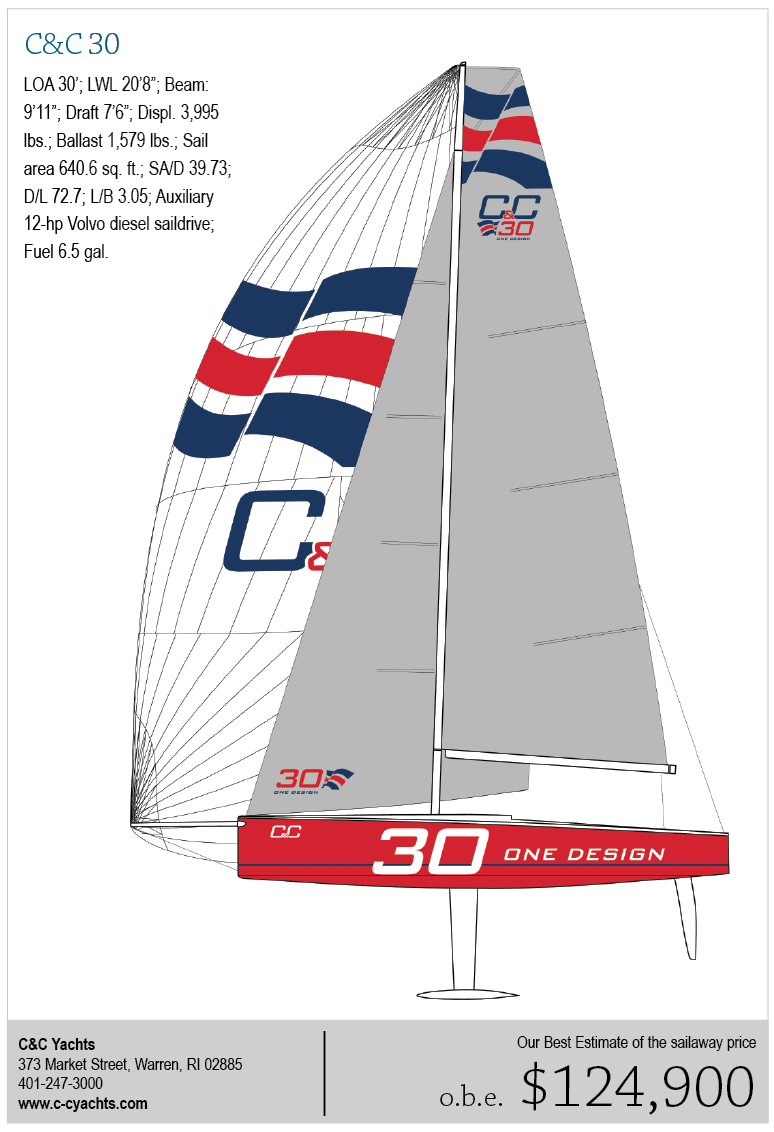C&C 30
One-design racer

Here’s a boat designed by my old friend Mark Mills that has a lot of people talking. The first boat is sailing and so far there have been big smiles all around. This new boat enters a tough niche in the market. We have quite a few exciting one-designs in this size range, so for Mark’s new design to take off, it will have to prove itself the superior boat in a wide variety of race conditions.
The hull has a powerful look to it. There are no hollows forward and there is a chine aft. Note that this chine is well above the DWL. Mark and I had a chat about this and Mark said the chine was needed for a variety of reasons. Given the performance the boat has shown, I would hardly say the chine hurts anything. It does push a small amount of volume outboard to improve stability and to flatten buttocks.
The D/L is 72.7 without crew. But given that this design is almost a ballasted dinghy, I am adding seven crew members averaging 180 pounds each to see how crew weight changes the D/L and SA/D. With our crew weight added the D/L is 96.5. The L/B is 3.05 with beam max being carried back to the transom.
If I just take the published displacement I get a SA/D of 39.73. “Hold on Grandma!” If I add our seven 180-pound crew members the SA/D is reduced to 32.89, “Come on Grandma, just hang on to Fred!”
If there is any taper aft to the planform of the deck it can’t be more than 1¾ inches per side. Of course in a boat as high powered as this one, getting crew weight as far outboard as possible pays huge benefits.
The draft is 7 feet 6 inches with a lead bulb on a retracting carbon fin. This is a very high aspect ratio fin. I can remember a time when IOR one-tonners did not draw 7 feet 6 inches.
Sportboats like this need perfect deck layouts. Crew weight placement is critical, upwind and down. Gear layout for efficient crew movement is critical. Lines have to be laid out so you can make adjustments from the high side so stability is not compromised with crew weight to leeward. Effort has to be made to keep crew weight out of the ends under most conditions.
The traveler spans the cockpit sole aft of the tiller head. The backstay winches are aft of the helmsman’s position. Foot bensons and-bossed up wedges for efficient line leads are just aft of the mainsheet centerline block.
There are four winches. The primary winches are forward and can take jib and spinnaker sheet leads from the opposite side if needed. Transverse jib sheet lead tracks allow for a sheeting angle range of 11 degrees down to 4 degrees. The spinnaker tack line leads aft through a clutch to the starboard primary. The carbon sprit can be removed for shipping the boat. Note the main companionway and the foredeck hatch are offset to port for ease with spinnaker handling in port mark roundings.
The mast is carbon by Hall Spars, and the boom is aluminum. No standing backstay is needed, which allows for the square topped mainsail. This is one high-powered boat. But the most fun comes from having the biggest rig you can control so you can slice along aggressively in light air and see speeds in the high teens when you have some breeze. You’ll have all the horsepower you need. The asymmetrical chute has 1,297 square feet of area.
People are ready and anxious to see this boat hit the racing circuit.

Comments